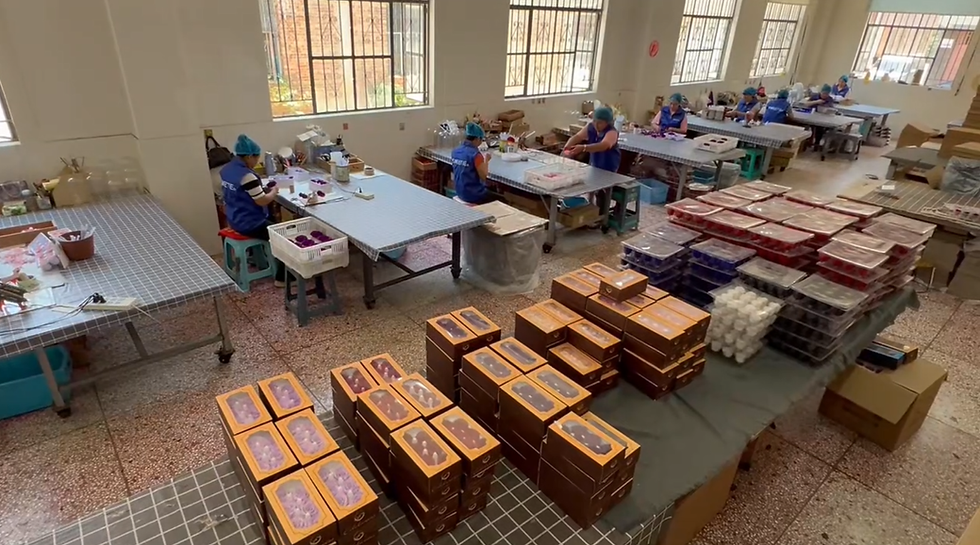How Long Do Preserved Flowers Really Last? A Practical Guide for B2B Buyers
- Annie Zhang

- Aug 6
- 4 min read
When you're sourcing floral gifts in bulk, product longevity isn't a minor detail—it's a core part of your value proposition. Imagine investing in 2,000 preserved flower boxes for Mother's Day, only to receive complaints a few months later that the colors have faded or petals are brittle. For B2B buyers, shelf life and color retention directly affect return rates, customer trust, and brand perception.
So, how long do preserved flowers actually last? And more importantly, what factors influence their lifespan? Let's explore the full picture—from science to sourcing.
Index:
1. The Typical Lifespan of Preserved Flowers
Preserved flowers aren't "eternal," but they are significantly longer-lasting than fresh flowers. With proper care, most preserved flower products remain visually appealing for 1 to 3 years. This is the industry standard across major markets in the U.S. and Europe.
Higher-end preserved flowers, often processed using glycerin-based solutions or advanced freeze-drying techniques, can last up to 4 or even 5 years. In rare, optimal storage conditions, some flowers may remain intact for 6 to 7 years, though this is less common and not guaranteed.
A key benchmark: if noticeable fading or petal deterioration occurs within 6 months, the product is typically considered substandard.
2. What Causes Preserved Flowers to Fade or Degrade?
Preserved flowers are real flowers that have been treated to maintain their shape and color, but they are still subject to environmental and chemical influences. Common reasons for degradation include:
UV Exposure: Ultraviolet light breaks down flower pigments like anthocyanins and carotenoids, causing fading.
Humidity and Temperature: High humidity can cause mold or fading, while extremely dry air can make petals brittle.
Air Quality: Pollutants such as cigarette smoke or industrial fumes can accelerate discoloration.
Touch and Friction: Oils from hands or frequent handling can degrade petals and transfer dirt that affects appearance.
Dye Stability: Poor-quality colorants used in the preservation process may degrade faster under light and air.

3. Manufacturing Methods and Their Impact
The preservation process has a direct impact on both the shelf life and appearance of the flowers. The most common methods include:
Alcohol-Based Dehydration:
High quality flowers are treated with ethanol to remove water and fats. This method is effective but requires precision to avoid brittle textures.
Glycerin Preservation:
This involves replacing natural moisture in the plant cells with glycerin, which maintains flexibility and extends longevity.
Freeze-Drying (Lyophilization):
This vacuum-based technique sublimates water from the flower while retaining its cellular structure. It's more expensive but offers longer-lasting results and better shape retention.
Coloring:
High-quality preserved flowers use food-grade or safe industrial-grade pigments. Lower-grade pigments often fade more quickly, especially under UV exposure.
4. Evaluating Product Quality: What Counts as "Unacceptable"?
For business buyers, it's important to define the line between acceptable and unacceptable quality:
Indicator | Acceptable Standard | Unacceptable Indicator |
Color stability | No significant fading within 12–18 months | Noticeable fading within 6 months |
Petal structure | Soft, flexible, intact | Brittle, curling, or flaking within 6 months |
Odor | Neutral or mildly scented (if added) | Musty, chemical, or burnt smell |
Consistency across SKUs | Stable across batches | High variance in color or shape per box |
Buyers should always request aging test reports or at least sample photos over time to validate a supplier's quality claims.

5. How to Store and Display for Maximum Lifespan
Once the product leaves the factory, the storage and retail environment can make or break its longevity.
Ideal Conditions:
Temperature: 15 to 25°C
Humidity: 40% to 60%
No direct sunlight
No exposure to moisture or steam
Best Practices for Retail Display:
Use closed or domed packaging for shelf display
Avoid placing near HVAC vents or windows
Include care instruction cards for downstream users
Maintenance Tips for End Customers:
Never water preserved flowers
Dust lightly with soft brushes or cold air every few months
Avoid direct handling
Educating your distributors or customers on these points can reduce complaints and improve retention.
6. What to Ask Suppliers Before You Buy
Before making a bulk purchase, here are critical questions you should ask:
What preservation method is used? (Alcohol-based, glycerin, freeze-dried?)
What is the expected shelf life under standard conditions?
Are pigments UV-stable?
Do you provide care instructions with the product?
What is your return/replacement policy for early fading?
Well-prepared suppliers will have answers to these questions, along with documentation or third-party testing to support their claims.

Final Thoughts
Preserved flowers offer a beautiful, long-lasting alternative to fresh blooms, but not all products are created equal. As a B2B buyer, understanding the science behind preservation, asking the right questions, and managing the full supply chain from factory to retail are key to ensuring your product lives up to its promise.
If you’re looking for a reliable partner with proven experience in global floral gift production, Sweetie-Group has been serving B2B clients for over 16 years. With advanced manufacturing, rigorous quality control, and customizable packaging options, we help you deliver beauty that truly lasts.
Contact us at sales@sweetie-group.com to request a catalog or samples.
Warm Regards,
CEO of Sweetie-Group









Comments